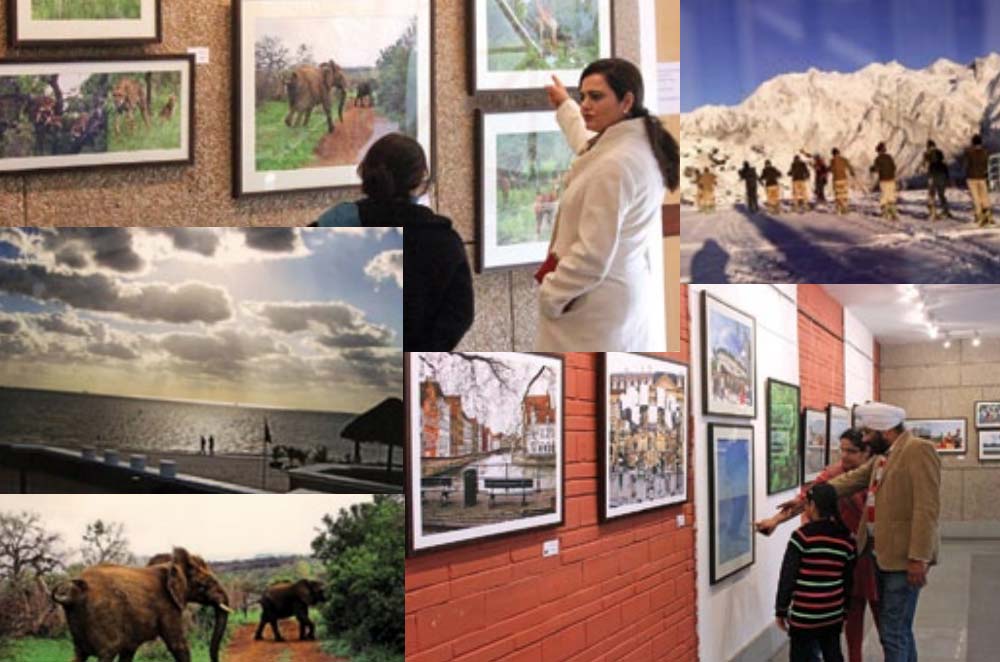NOVEL and Ashok Lavasa carried forward their journey of exploring nature and brought its many facets together in an exhibition of their photographs in New Delhi recently.
This time, their ‘Stand & Stare’ collection offers images of ‘Mates & Moments’. Apparently these seem unrelated as many things in the world would seem to the human eye. The inward eye, however, is able to discover the inherent harmony that pervades creation.
Novel and Ashok Lavasa are not professional photographers. They are two sensitive souls that are out to assimilate life. They do so by a passionate lifestyle that reflects in their work, social interaction and incessant travel when they interact with nature. Mountains, waterfalls, the setting and rising sun, trees, monuments and men all form a part of their landscape.
The stripes of a zebra, the spots of a giraffe, and lions on a tree are as enchanting as the eyes of birds in bliss or flapping their wings in the sands of a desert. The balance in life that companionship brings is akin to the glory reflected in the light and shade created by the sun when its rays land on an object that shines, at the same time diverting the journey of the rays and creating a contrast that completes the harmony of vision. The shimmering waters of the sea, the glittering peaks of the mountains, trees bearing the burden of spring and trees bereft of leaves represent the harmony of life. Mates in many moods, mountains in majestic isolation and moments that live in memory – all these captured in moments of splendid irony and pleasing tranquillity. They say that “in these times of tension and turmoil, it is tolerance, togetherness and tenderness that will take us to the other end. Companionship is part of nature, compassion brings beings closer and together they create indelible moments.”
The photograph of the Berlin Wall with graffiti on it dominates the gallery as a symbol of the theme of the exhibition with two countries that once stood divided by an artificial barrier now stand united as ‘mates’ with one single ‘moment’ determining the destiny of millions. The Berlin Wall was erected in the dead of night. Just past midnight on the night of August 12-13, 1961. For 28 years, families, friends, and lovers across the border were separated from their loved ones. Its destruction, which was nearly as instantaneous as its creation, was celebrated around the world. On the eve of November 9, 1989, as an official announcement was made by East German government, the Berlin Wall was inundated with people from both sides. Some began chipping at the Wall with hammers and chisels. These people were nicknamed “Mauerspechte” (wall woodpeckers). There was an impromptu celebration, with people hugging, kissing, singing, cheering, and crying. East and West Germany reunified into a single German state on October 3, 1990. Little is left of the Wall at its original site. The broken walls of a city that unite two countries mark that ‘mating moment’ when barriers erected by history and impediments of ideology are dissolved. Hearts and homes divided by humans are united.
Yet another photograph marks the recreation of those that perished in an accident in 1628 in Sweden when a ship named ‘Vasa’ sank. It was a fearsome war machine with 64 guns and 450 men, of them 300 soldiers. It sank within minutes of its launch on August 10, 1628 but was salvaged after 333 years on April 24, 1961 and is now preserved in the Vasa Museum in Stockholm. It is believed that about 30 men, women and children died in the catastrophe. At least 15 skeletons were found during excavations. Some were found outside the ship but have been dated by the radiocarbon method, and were most probably victims also. In connection with research on these skeletons, each has been given a name in alphabetical order following the Swedish letter-naming system – “Adam”, “Beata”, “Cesar”, etc. What can be said about “Adam” is that he was 35-40 years old, 165 cm tall and in good health, but that in his youth he had received a blow to the face. He was one of the first skeletons to be salvaged by divers in 1958. The individual F, “Filip”, was probably a sailor who died at his post. He was c. 30 years old, 163 cm tall and had a set of teeth that gave him a special smile. “Ylva” was identified in the beginning as a boy, but was in fact a 16-year-old girl in poor health. Her skeleton shows several injuries and she was stooped and undernourished. The unknown dead have been given a name and a new life.
The Lavasas are compulsive travellers, love music, river rafting, trekking, racquet games and reading. Novel worked for the State Bank of India for 28 years, is now an entrepreneur growing exotic vegetables in a poly house, organises adventure camps for women and is also a CSR consultant. Her husband Ashok is in the Indian Administrative Service and is currently posted as Secretary, Civil Aviation, in Government of India.
While Novel has written occasional pieces on their travels, Ashok’s first book ‘An Uncivil Servant’ was published in 2006. They have participated in various exhibitions and have also had solo exhibitions in different cities. The last exhibition of their photographs ‘Inward Eye’ was held in 2010 in New Delhi.





























































